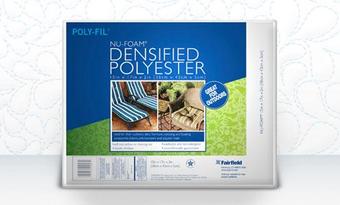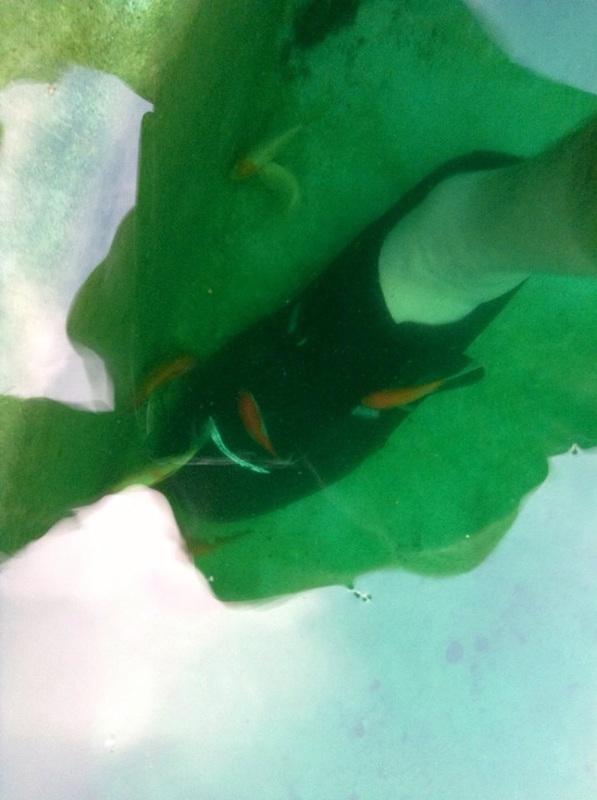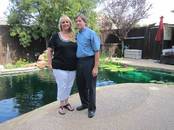 Poly-fil Nu-Foam by Fairfield
Poly-fil Nu-Foam by Fairfield As I've mentioned before, our pond is for SWIMMING, but we were dealing with constantly cloudy water caused by both silt from the sandbags, decaying plant matter and excess algae, so to actually use the pond this summer we needed to do something quick!
First we removed the cannas - they weren't very happy with their roots continually under the water. We planted them in the border of our landscaping and replaced them with some reasonably priced small water lilies we found on Craigs List to help keep the water shaded.
As for filtering, running our regular pool filter works fine for the short term, although the water pressure sent out through the waterfall is pretty strong, which the water lilies don't like, and Jim has to pressure wash the pool filter regularly to remove the particulates, which Jim doesn't like. We run our pool pump most hours of the day to keep the water circulating and oxygenated. Our intermediate term plan is to build a bio-filter and install a pond pump with a UV light, which is much more efficient and less costly to run, but we don't want to jump in and spend money before we are absolutely sure what kind of filter we want to build and the size pump we'll need.
So, to tackle the cloudy water issue in the short term, I spent a bit of time researching online in various pond forums to see what other people do for their man-made koi ponds to keep the water clear. I found some advice in a forum on American Ponders posted several years ago that seemed like an affordable fix. One person went to a fabric store and purchased Nu-foam, a type of densified polyester used to make pillows and seat cushions, and fit them into his pond skimmers to trap algae. He said that he rinsed them out twice a day at first, and that after a few days his 3,000 gallon pond was clear! To keep it clear, he continued to rinse them once per day. I liked this idea because while you can purchase all kinds of additives to reduce algae and clear water, it costs money on a regular basis and adds chemicals, which is what we're trying to get away from.
I went to our local Hancock Fabrics and found Nu-Foam on sale for 50% off, so I chose several 16"x16" squares that were 1-inch thick. We cut them to fit our skimmer baskets and piled them in. Jim took on the job of rinsing and replacing them and after the first day, we found them to be bright green with trapped algae! The 1-inch thick Nu-Foam started to get a little raggedy early on, so we went back to Hancock Fabrics and purchased the 2-inch thick squares. They work just as well and seem to hold up better under the regular rinsing. After nearly a week of switching and rinsing out our Nu-Foam twice per day we found our water becoming incredibly clear! Now we maintain it by changing them out every other day and it's still working well. Almost too well, in fact!
Our Comet goldfish have eaten much of the algae from the sides of the pond and they've tripled in size since we put them in six weeks ago! The major component of their diet is supposed to be algae, so we're debating on the bio-filter right now. They will get upwards of 13" long - that's a LOT of algae to keep them fed! I began supplementing their diet with floating food pellets last week, which they love. We've already taught them to come to the shallow end to eat so we can keep track of them every day. They already know us and swarm around our feet whenever we come into the pond!
First we removed the cannas - they weren't very happy with their roots continually under the water. We planted them in the border of our landscaping and replaced them with some reasonably priced small water lilies we found on Craigs List to help keep the water shaded.
As for filtering, running our regular pool filter works fine for the short term, although the water pressure sent out through the waterfall is pretty strong, which the water lilies don't like, and Jim has to pressure wash the pool filter regularly to remove the particulates, which Jim doesn't like. We run our pool pump most hours of the day to keep the water circulating and oxygenated. Our intermediate term plan is to build a bio-filter and install a pond pump with a UV light, which is much more efficient and less costly to run, but we don't want to jump in and spend money before we are absolutely sure what kind of filter we want to build and the size pump we'll need.
So, to tackle the cloudy water issue in the short term, I spent a bit of time researching online in various pond forums to see what other people do for their man-made koi ponds to keep the water clear. I found some advice in a forum on American Ponders posted several years ago that seemed like an affordable fix. One person went to a fabric store and purchased Nu-foam, a type of densified polyester used to make pillows and seat cushions, and fit them into his pond skimmers to trap algae. He said that he rinsed them out twice a day at first, and that after a few days his 3,000 gallon pond was clear! To keep it clear, he continued to rinse them once per day. I liked this idea because while you can purchase all kinds of additives to reduce algae and clear water, it costs money on a regular basis and adds chemicals, which is what we're trying to get away from.
I went to our local Hancock Fabrics and found Nu-Foam on sale for 50% off, so I chose several 16"x16" squares that were 1-inch thick. We cut them to fit our skimmer baskets and piled them in. Jim took on the job of rinsing and replacing them and after the first day, we found them to be bright green with trapped algae! The 1-inch thick Nu-Foam started to get a little raggedy early on, so we went back to Hancock Fabrics and purchased the 2-inch thick squares. They work just as well and seem to hold up better under the regular rinsing. After nearly a week of switching and rinsing out our Nu-Foam twice per day we found our water becoming incredibly clear! Now we maintain it by changing them out every other day and it's still working well. Almost too well, in fact!
Our Comet goldfish have eaten much of the algae from the sides of the pond and they've tripled in size since we put them in six weeks ago! The major component of their diet is supposed to be algae, so we're debating on the bio-filter right now. They will get upwards of 13" long - that's a LOT of algae to keep them fed! I began supplementing their diet with floating food pellets last week, which they love. We've already taught them to come to the shallow end to eat so we can keep track of them every day. They already know us and swarm around our feet whenever we come into the pond!


 RSS Feed
RSS Feed
